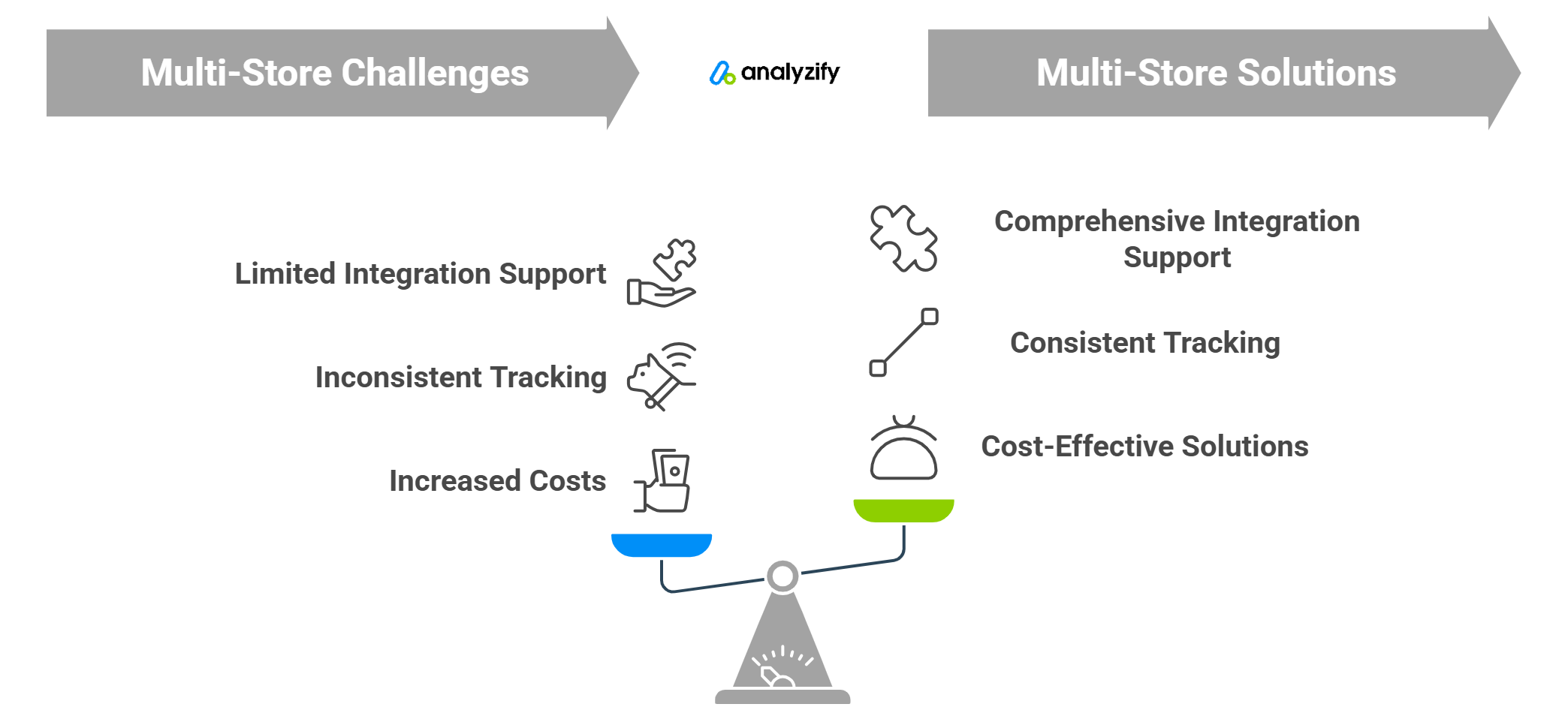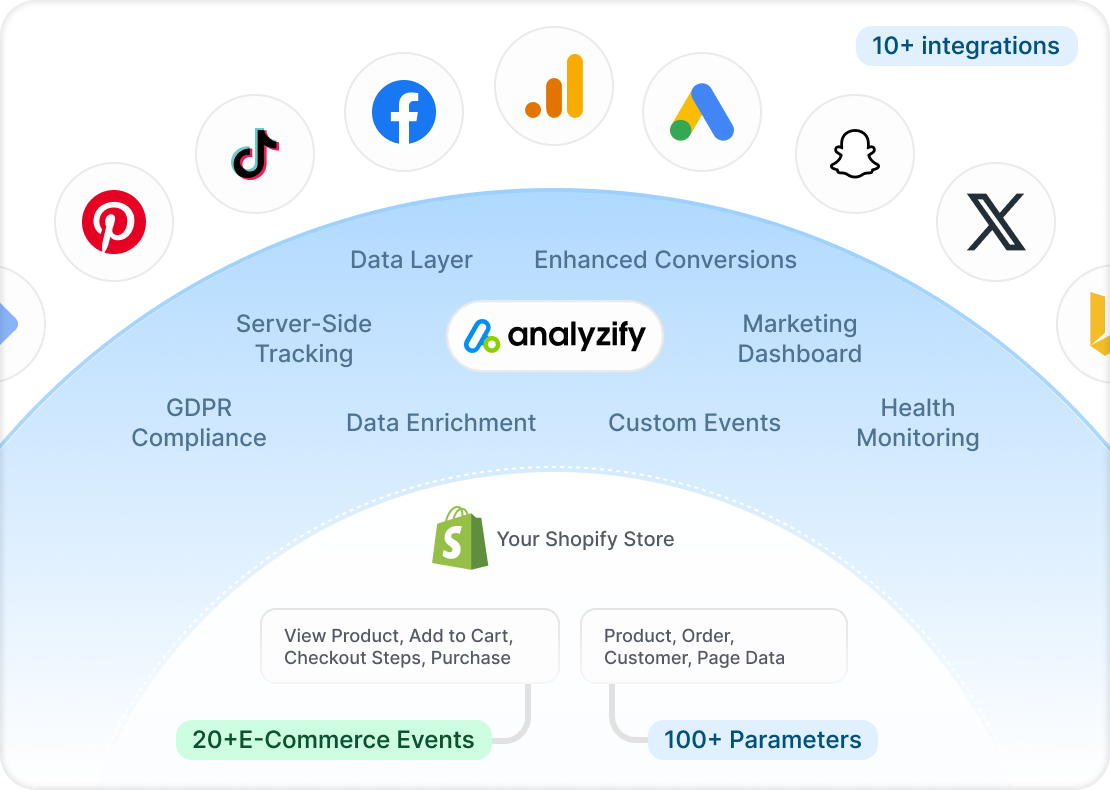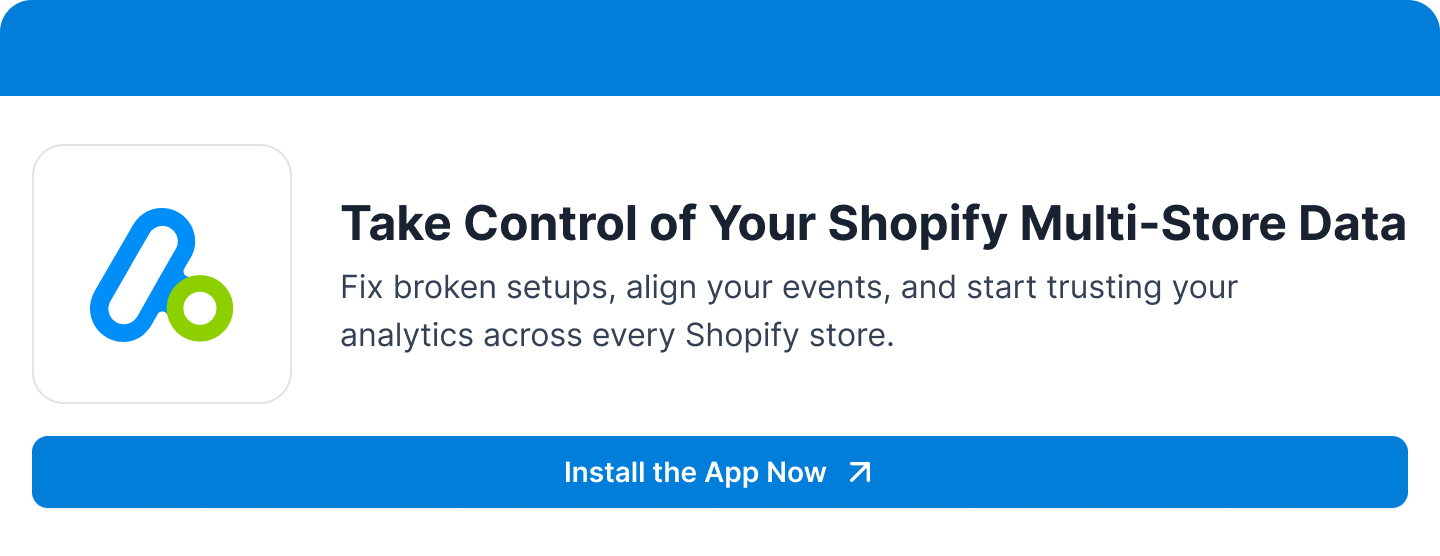If you’re selling in different markets, serving both B2B and DTC, or separating product lines, opening multiple Shopify stores can be a smart move.
But as your store count grows, so do the challenges of keeping your analytics consistent, accurate, and scalable.
It’s not just copy-pasting one store—you’re entering multi-store data analytics for Shopify, where tracking often breaks and data gets messy.
In this post, you’ll learn about the most common challenges of managing data analytics across multiple Shopify stores, and see how to build a structured, scalable setup that supports your growth—without losing trust in your data.
The Complexity of Data Analytics For Multiple Shopify Stores

On the surface, running multiple Shopify stores might seem like a simple copy-paste job—duplicate your theme, replicate your setup, and you’re good to go.
But when it comes to data analytics for multiple Shopify stores, every new store adds a new layer of complexity.
Without a unified, strategy-led approach, you’ll likely run into:
- Tracking discrepancies between stores
- Attribution issues due to cross-domain behavior
- Inconsistent data structures that make comparisons unreliable
- Tool costs that scale with each new store
Each store has its own nuances—different currencies, customer behaviors, product categories, and marketing campaigns.
If your tracking setup doesn’t adapt to those differences after switching to Shopify multiple stores, you end up with data that’s inaccurate, incomplete, or just plain confusing.
Here’s what’s making data analytics for multiple Shopify stores difficult for Shopify merchants and how to fix it:
1. More Stores Means More Costs
Each new store you add doesn’t just duplicate your sales potential—it also duplicates your costs.
Setting up analytics, managing tracking scripts, and maintaining tools like Google Tag Manager or GA4 for every store quickly adds up.
Even small changes require repeating work across multiple sites, eating into both time and budget.
The Solution: 20% Discount on Each Additional Store (For Shopify Multi-stores)
To make scaling more affordable, we offer a 20% discount for each additional Shopify store added to your tracking setup.
You get the same expert service and accurate implementation—just at a more manageable cost as your brand grows.
2. Inconsistent or Broken Tracking Across Stores
When running multiple stores on Shopify, each store is set up separately, it’s easy for tracking to break or misalign.
One might have Google Tag Manager installed correctly, another might be missing GA4 events, and a third could have outdated scripts from an older setup. The result? Messy, incomplete, or missing data that you can’t trust.
Even worse, if something breaks, you might not notice until it’s too late—costing you weeks or months of valuable data.
The Solution: In-Depth Audit of Your Data Analytics for Multiple Shopify Stores
Analyzify starts by reviewing your entire tracking environment—across every store—to catch inconsistencies, errors, or gaps.
From there, we standardize your setup and ensure everything is aligned, so your data stays accurate and actionable across the board.
3. Native Integrations Struggle with Multi-Currency and Multi-Store Setups
Shopify’s native integrations for tools like GA4 and Google Ads might work fine for a single store—but when you’re operating across multiple stores or currencies, those setups quickly show their limits.
Most native solutions don’t cover essential e-commerce events. Key actions like coupon usage, checkout steps, or purchase details are often missing, leading to incomplete data in your reports.
Google Ads’ native integration also lacks enhanced conversion tracking, which means you’re not sending the most accurate purchase data back to your ad platforms—hurting your optimization efforts.
When your multi-stores operate in different currencies, languages, or domains, tracking becomes even more fragile. Native setups simply aren’t designed to handle that level of variation.
The Solution: Expert-Led, All-Inclusive Setup with Analyzify
Analyzify solves these issues with a fully managed, end-to-end tracking solution—tailored for data analytics for multiple Shopify stores and multi-currency complexities.
We audit your current setup, implement the missing pieces, and validate everything with ongoing monitoring. While our app supports self-service, we strongly recommend the Done-For-You setup for multi-store brands. It ensures everything works seamlessly—and stays that way.
4. Disconnected Customer Journeys Between Stores
Customers don’t always stay in just one store. They might start browsing on your US site, click through to your EU store, or bounce between B2B and DTC versions.
Without proper tracking in place, these cross-store journeys break sessions, lose attribution data, and confuse your analytics tools.
That means you can’t accurately track where users came from, what they did, or what led to a conversion—making your marketing data analytics for multiple Shopify stores unreliable.
The Solution: Cross-Domain Tracking Implementation
Analyzify implements cross-domain tracking that connects customer sessions between stores, so their journey is recorded as a single, unified experience.
This ensures accurate attribution, clean conversion paths, and better decision-making across your marketing channels.
5. Generic Tracking Fails in Multi-Store Shopify Setups
Each of your stores likely serves a different purpose—whether by region, customer type, or product strategy.
So why force them all to use the same tracking setup? A generic implementation can lead to irrelevant data, missed events, or unnecessary complexity.
For example, a store selling digital products may need different conversion events than one handling physical goods with shipping and returns. Without customization, you lose clarity—and insights.
The Solution: Tailored Data Tracking Plan for Your Needs
We design a custom tracking plan for each of your stores, based on its unique goals, audience, and platform setup.
Whether that means regional compliance, specific funnel tracking, or platform integrations, Analyzify makes sure your tracking is optimized—not just replicated.
Read More:
6. Inconsistent Shopify Data Makes Multi-Store Performance Hard to Compare
When each store collects and structures data differently, it’s nearly impossible to compare performance.
You might be looking at revenue growth on one store, conversion rates on another—but the numbers aren’t aligned, and you’re not comparing apples to apples.
This makes it hard to know what’s working, where to invest more, or which markets are underperforming. Inconsistent data means inconsistent decisions.
The Solution: Consistent Data Collection Across All Stores
Analyzify unifies your tracking structure across stores—standardizing events, goals, and naming conventions—so you can confidently compare performance.
That way, your reports are clean, your benchmarks make sense, and your growth strategies are backed by solid data.
7. Lack of Hands-On Support for Complex Setups
Data analytics for multiple Shopify storess setups are rarely simple. From syncing tools across stores to troubleshooting advanced tracking issues, things get technical fast.
Most Shopify merchants don’t have time to manage all of this—or access to experts who really understand the nuances of Shopify tracking.
Without dedicated support, you’re left dealing with multiple tools, guessing through fixes, and hoping your data is right.
The Solution: Dedicated Support for Your Shopify Multi-Store Data Analytics
With a dedicated expert on your side, you get hands-on help every step of the way.
From implementation to troubleshooting, you’ll always have someone who understands your setup—and makes sure everything runs smoothly, accurately, and stress-free.
Shopify Multi-Store Tracking You Can Trust: Analyzify

Managing data analytics for multiple Shopify stores doesn’t have to be messy, manual, or expensive.
Analyzify gives you a structured, scalable solution—so you can trust your data, save time, and make smarter decisions across all your stores.
Here’s how Analyzify helps you simplify and scale multi-store analytics:
With Analyzify, you don’t just get tracking—you get clarity, control, and a partner that grows with you.
Exploring Reliable Data Analytics for Multiple Shopify Stores
When you’re managing more than one Shopify store, you need more than just basic tracking—you need a reliable, full-featured analytics solution that grows with you.
Behind the scenes, we’re working to make your entire Shopify analytics ecosystem stronger, more reliable, and easier to manage.
Here’s what else you get with Analyzify:
🎯 Learn More: A More Powerful Analyzify (Reliable & Simple Shopify Data Analytics)
👉 Book a free demo to see how Analyzify helps you track conversions, user journeys, and performance across all your Shopify stores—with reliable, consistent data.
Or, if you’re ready to get started:

FAQs: Data Analytics For Multiple Shopify Stores
Here are the frequently asked questions about multi-store analytics for Shopify stores:
1. How can I reduce the cost of tracking multiple Shopify stores?
Tracking tools and setups often multiply with each new store—making it costly to scale. Analyzify helps you keep costs under control with a 20% discount on each additional store, while still providing full-featured, expert-led analytics implementation.
2. Why is my tracking inconsistent across different Shopify stores?
Each store may have different tracking setups, outdated scripts, or missing integrations—especially if you’ve added them over time. Analyzify performs an in-depth audit across all your stores to identify inconsistencies and fix them at the root.
3. Do native Shopify integrations work well for multi-store and multi-currency setups?
Not always. Native tools like GA4 and Google Ads often miss key events, don’t support enhanced conversions, and struggle with cross-currency or cross-domain setups. Analyzify fills these gaps with a custom, complete integration—done for you.
4. Can I track customers as they move between my Shopify stores?
Yes—but only with cross-domain tracking. Without it, sessions break and attribution gets lost. Analyzify connects user journeys across all your stores, so you can see where they came from and what drove the final conversion.
5. Should I use the same tracking setup for all my Shopify stores?
Not if each store has different goals or strategies. A one-size-fits-all setup leads to irrelevant or missing data. Analyzify creates a tailored tracking plan for each store—so your data always aligns with what you’re trying to measure.
6. Why can’t I accurately compare performance across my Shopify stores?
If your stores collect data differently, you’re not comparing like-for-like. Analyzify standardizes your tracking structure across all stores, making it easy to measure and benchmark performance in one reliable view.
7. What kind of support do I get with Analyzify for multi-store tracking?
Multi-store tracking can be complex—and we don’t leave you to figure it out alone. Analyzify provides a dedicated account manager who handles setup, troubleshooting, and ongoing optimization for all your stores.
8. Is Analyzify compliant with GDPR, CCPA, and other privacy laws?
Yes. We help implement privacy-first tracking using tools like Google Consent Mode and leading CMPs. You stay compliant—without sacrificing the accuracy of your analytics.
9. What’s the best data analytics for multiple Shopify stores?
If you’re managing multiple Shopify stores and want accurate, complete, and scalable analytics, Analyzify is the most trusted choice. From cross-domain tracking and server-side setups to expert-led implementation, we cover everything—so you can trust your data and grow your stores with confidence.
Conclusion
Running multiple Shopify stores comes with real analytics challenges—but they’re not impossible to solve. With the right tracking setup, you can turn messy data into reliable insights, compare store performance with confidence, and grow your brand strategically.
Analyzify gives you the tools, support, and structure you need to make data analytics for multiple Shopify stores seamless and scalable.
Ready to take control of your data? Contact us here.

































